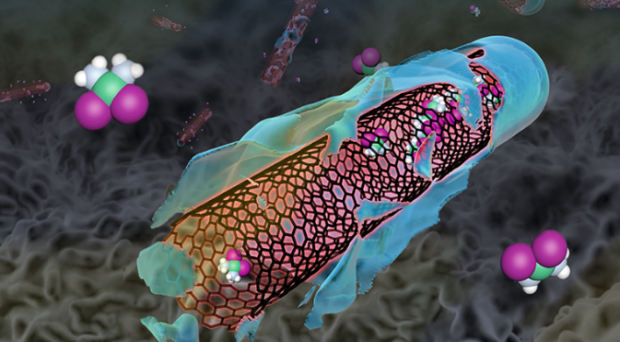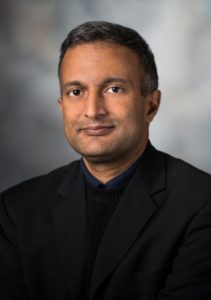
As you can read about here, we are delighted to welcome Sunil Krishnan of MD Anderson, Houston, Texas, as a new co-Editor-in-Chief of Cancer Nanotechnology. Sunil will join existing Editors-in-Chief Fred Currell, Dalton Cumbrian Facility, University of Manchester, UK, and Steve Curley, CHRISTUS Trinity Mother Frances, Texas, in helping to make Cancer Nanotechnology a premiere venue for research of its kind.
We caught up with Sunil to find out a bit more about him, his research and how he feels about his new role on the journal.

Sunil, congratulations on becoming an EiC of Cancer Nanotechnology! How do you feel about your new position?
I’m excited to take on this new role on the editorial board and to join two friends and colleagues. I hope to bring renewed energy and enthusiasm to the role and shepherd the journal to its rightful place amongst journals dealing with nanotechnology applications in the realm of oncology. There is clearly a renaissance of interest in this area of research and Cancer Nanotechnology should serve as a venue for original high-quality research articles, review, editorials and commentaries in this arena.
Would you tell us a little about yourself, your research and how it fits into the scope of Cancer Nanotechnology?
I am a radiation oncologist by training and a nanotechnology researcher by choice. I treat gastrointestinal cancers with radiation at MD Anderson Cancer Center in Houston, Texas, and direct the Center for Radiation Oncology Research for the institution. I began this journey by trying to image tumors using bioconjugated quantum dots back when quantum dots were the new kid on the block making a lot of waves. We performed what we believe was the first comprehensive biodistribution and pharmacokinetic analysis of this conjugated nanoparticle and slowly taught ourselves more about nanotechnology. We have spent many years working on gold nanoparticles as sensitizers of tumors to radiation therapy and tried to understand ionizing radiation-nanoparticle interactions at a mesoscopic scale. We currently continue to work on ways to couple clinically utilized radiation techniques with nanoparticles of different flavors to see if unique applications can be identified, understood, and translated. To that end, our team comprises experts in disparate disciplines like materials science, chemistry, physics, cancer biology, immunology, and biomedical engineering. Working with researchers across disciplines that do not often intersect or interact has not only expanded our horizons in terms of research interests but also broadened our understanding of fields that we need to fully incorporate into a common vocabulary that unites efforts to image and treat cancer effectively.
Today’s science is collaborative, multi-disciplinary and symbiotic
The journal has a broad base, covering all aspects from basic research to clinical applications. Are there any areas of the scope that you feel the journal is not yet covering that you would like to focus on as EiC?
I see Cancer Nanotechnology serving as a bridge that connects research endeavors in disciplines as diverse as material science, chemistry, pharmacology, biomedical engineering, tumor biology, molecular biology and clinical oncology. Rather than have the literature spanning these disciplines remain buried in specialty journals of each discipline, I see the need for and the power of having a comprehensive repository of high-quality research material under one roof in a journal like Cancer Nanotechnology. So the scope should continue to be broad, spanning from basic research to clinical application and should remain especially receptive to studies at the intersection of the disciplines listed above. In the end, this should be a resource for all enthusiasts of the sciences dealing with oncology and nanotechnology in any shape or form, a point of reference that appeals equally to newcomers and veterans in these sciences, and a watering hole for any who seek to indulge in similar endeavors.
How is the growth of open access affecting this field?
Open access is a growing trend in this field because it eliminates an entry barrier, levels the playing field and increases accessibility to a larger audience. It is especially fitting that a journal straddling the divide between say the physical sciences and the biological sciences is one that is accessible to researchers who have different perspectives, different terminologies and different vocabularies. So I see open access as a most logical choice for Cancer Nanotechnology.
Finally, what do you see as being the key advances and challenges in the coming years in cancer nanotechnology research?
I feel the days when cutting edge research was performed in an isolated laboratory specializing in a single discipline are long gone. Today’s science is collaborative, multi-disciplinary and symbiotic. New discoveries are likely to sprout from planes of intersection between dissimilar disciplines or when a discipline crosses over into another, much like this year’s Nobel Prize for physiology and medicine that stemmed from the desire to study the behaviour of T cells (immunology) and ended up revolutionizing the treatment of cancer. While breaking down silos and creating bridges across disciplines can only be a rewarding exercise, two unique challenges faced by nanotechnology advances in the medical world are those of over-promising and under-delivering, and inadequate attention to reproducibility, scalability and biocompatibility of nanoprobes and nanoconstructs. While being mindful of these potential pitfalls, the field remains exciting, refreshing and promising for the foreseeable future.
Be sure to visit the Cancer Nanotechnology homepage and sign up for article alerts to stay up-to-date with new happenings in the journal.
Comments